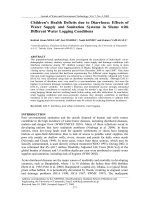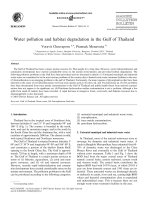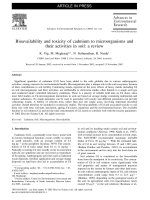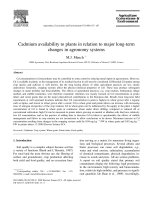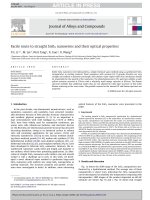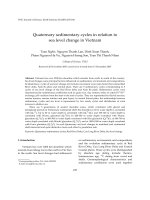Undaria pinnatifida Habitat Loss in Relation to Sea Urchin Grazing and Water Flow Conditions, and Their Restoration Effort in Ogatsu Bay, Japan
Bạn đang xem bản rút gọn của tài liệu. Xem và tải ngay bản đầy đủ của tài liệu tại đây (329.61 KB, 13 trang )
Journal of Water and Environment Technology, Vol. 7, No. 3, 2009
Undaria pinnatifida Habitat Loss in Relation to Sea
Urchin Grazing and Water Flow Conditions, and Their
Restoration Effort in Ogatsu Bay, Japan
Hitoshi TAMAKI*, Keisaku KUSAKA**, Minji FUKUDA***, Shogo ARAI**** and
Daisuke MURAOKA*****
* Ishinomaki Senshu University, 1 Shinmito, Minamisakai, Ishinomaki, Miyagi, 986-8580, Japan
** Miyagi Prefectural Eastern Regional Promotion Office, 1-4-32, Higashinakasato, Ishinomaki,
Miyagi, 986-0812, Japan
*** Fukuda Ocean Research, Ltd, 166 Asahigaura, Watanoha, Ishinomaki, Miyagi, 986-2135,
Japan
**** Aqua Scape Research Co., Ltd, 622-1 Ushirodani, Takugi, Okinoshima, Oki, Shimane,
685-0106, Japan
***** Tohoku National Fisheries Research Institute, 3-27-5 Shinhama, Shiogama, Miyagi,
985-0001, Japan
ABSTRACT
This study investigated the mechanism of the loss of Undaria pinnatifida beds in Ogatsu Bay,
Japan. Wave heights at the outside of the bay were 1 to 2 m over the course of study. In the
outer areas of the bay with high water velocities, more than 14.5 ± 3.4 cm sec -1, U. pinnatifida
grew densely and sea urchins were scarce. However, in some outer areas with lower velocities,
less than 7.8 ± 2.3 cm sec -1, U. pinnatifida grew sparsely where the aggregation of sea urchin
was found. In contrast, in the inner areas of the bay with calm water having velocities of 2.4 to
4.6 cm sec-1, the density of sea urchin was high and the U. pinnatifida beds disappeared. These
results indicated high water velocities in the outer bay areas prevent the grazing by sea urchins.
Disappearance of U. pinnatifida in the inner bay areas seemed to be caused by the high grazing
pressure of sea urchins in calm water velocity conditions.
We also performed a U. pinnatifida restoration effort to reduce the effects of the grazing pressure
by sea urchins in the barren grounds in the inner areas of the bay. Artificial buoyed reefs were
designed to prevent the migration of sea urchins by being detached from the bottom and allowed
the recovery of U. pinnatifida and other non-encrusting macroalgae. Although there were some
losses of transplanted U. pinnatifida partly caused by the withering after the reproductive
maturation period, Saccharina japonica and other macroalgae were naturally recruited and
increased due to the inhibition of migration by sea urchins using the buoyed reefs. In contrast,
the formation of barren community remained at the area grounded to the bottom allowing the
migration of urchin in the inner bay. Overall, our restoration efforts using the artificial buoyed
reef, although not ideal, resulted in the success of the recovery of macrolagal habitats in the sea
urchin - dominated barren grounds by the reduction of grazing pressure of sea urchins.
Keywords: sea urchin, Undaria pinnatifida, water velocity.
INTRDUCTION
Undaria pinnatifida (Harvey) Suringar is an annual macroalga that grows in rocky
coastal areas (Arasaki et al., 2002). Forests of U. pinnatifida are highly productive
components of estuaries and coastal ecosystems, and support diverse faunal
assemblages (Ohno, 1996). They provide suitable habitats for many commercial fishes
and benthic animals (Ohno, 1996; Takami et al., 2003; Tamaki et al., 2005). U.
pinnatifida is also a significant commercial marine food product in Japan (Akiyama et
al., 1982; Ohno, 2004).
Address correspondence to Hitoshi TAMAKI, Ishinomaki Senshu University,
Email:
Received 11 March 2009, Accepted 10 July 2009
- 201 -
Journal of Water and Environment Technology, Vol. 7, No. 3, 2009
Subtidal marine macrophyte habitats around the world, including U. pinnatifida, have
declined due to human pollutants (Short et al., 1996; Tamaki et al., 2002), overgrazing
by sea urchins (Alcoverro et al., 2002; Kawai et al., 2002; Terawaki et al., 2002) and
herbivorous fishes (Nakayama et al., 2005; Tamaki et al., 2008), as well as natural
disturbances (Ito, 2001). In Vestfjorden, Northern Norway, an outbreak of the green
sea urchin Strongylocentrotus droebachiensis has resulted in the decrease of large kelp
forests and has remained a barren community configuration dominated by crustose
coralline algae (Hagen, 1995). Losses of kelp forests in Hokkaido, Japan, have been
ascribed to the overgrazing pressure of sea urchin Strongylocentrotus nudus (Kawai et
al., 2002).
U. pinnatifida had inhabited in the inner areas of Ogatsu Bay, Japan, but declined during
the 1990s and resulted in the formation of barren grounds with the aggregations of sea
urchin Strongylocentrotus nudus as the potential algal herbivores (Tamaki et al., 2005).
However, there are many areas where U. pinnatifida remains even with the high
abundance of herbivorous sea urchin in the outer areas of the bay. Here, we studied
the biological and physical characteristics of these areas to elucidate factors responsible
for the deterioration of U. pinnatifida habitats in the inner areas of Ogatsu Bay, Japan.
We carried out a comparative study on the distribution of U. pinnatifida and other
macrophytes, bottom sediments, flow regime and density of sea urchin between the
inner and outer areas of the Bay. We also performed a U. pinnatifida restoration effort
to reduce the grazing pressure by sea urchins in the barren grounds in the inner areas of
the bay.
MATERIALS AND METHODS
Study site
The study was carried out in the inner and outer areas of Ogatsu Bay, Pacific coast of
northern Honshu, Japan, between September 2003 and August 2005 (Fig. 1A). Both
areas are characterized by rocky shore and the occurrence of U. pinnatifida was
confirmed until 1990s (Tamaki et al. 2005). Inner area of the bay is protected from
waves and currents, whereas the outer area is exposed to excessive levels of
hydrodynamic energy. We deployed 50 m × 1 m belt transects in the outer area (Line 1,
38° 29’ 20.0” N; 140° 29’ 55.0” E) and the inner area (Line 2, 38° 30’ 07.6” N; 140° 29’
34.3” E) of the bay. Macrophyte communities at each line were confirmed to be
representative vegetation in the outer or inner bay area by the previous field
observations. The distance between the two surveyed lines is approximately 1.5 km.
Composition of substratum, macrophyte flora and infauna
The substratum of the bottom sediment, percentage covers of macroalgae and seagrass,
and the population of infauna were quantified in the 50 m × 1 m belt transects in the
outer (Line 1) and inner (Line 2) bay areas by scuba divers in September 2003 and 2004.
These belt transects were divided into six to nine surveyed sections classified by the
differences in macrophyte compositions and the bottom sediments. The percentage
covers of macroalgae and seagrass were estimated following the method of Turner et al.
(2004). Bottom sediments were expressed as bedrock, isolated rock, boulder, cobble,
pebble, sand and mud according to the size classification of Fujita et al. (2003).
- 202 -
Journal of Water and Environment Technology, Vol. 7, No. 3, 2009
(A)
(B)
141º 30’ E
Mean Low Water Level
0.4 m
Line 2
Inner areas
38º
30’ N
Miyagi
Prefecture
Artificial 2.5 m
buoyed
2.5 m reef
Outer areas
rope
Line 1
Bottom
Ogatsu Bay
1.5 m
1 km
Fig. 1 – (A) Location of the study area in Ogatsu Bay. Macrophyte communities at
each surveyed line were confirmed to be representative vegetation in the outer or inner
bay area by the previous field observations. ●: Two sets of artificial buoyed reefs were
deployed to allow the recovery of U. pinnatifida and other non-encrusting macroalgae.
(B) Diagram showing the artificial buoyed reefs at the restoration area.
Effect of water velocities on the distribution of sea urchins and U. pinnatifida
Field surveys of the water velocities at randomly selected ten U. pinnatifida habitats and
twenty unvegetated areas in Line 1 and Line 2 were conducted in September 2004 and
August 2005. Each area for the measurement of water velocity was separated from the
others by 3 to 5 m. Wave heights at the outside of the bay were 1 to 2 m over the
course of the study. Water velocity was estimated to average the maximum velocity in
60 seconds (n = 3) at 5 cm above the bottom, using a portable waterproof velocity meter
(Tokyo Keisoku Co. Ltd. and DIV Ltd., Japan). In addition, the densities of U.
pinnatifida and sea urchin were recorded using 0.25 m2 quadrat in each area.
Restoration effort
We performed a U. pinnatifida restoration effort to reduce the effects of grazing
pressure of sea urchins in the barren grounds adjacent to Line 2 (Fig. 1A). Two sets of
artificial buoyed reefs were moored in the middle depth of water using ropes and
weights in December 2004 (Fig. 1B). The buoyed reefs were deployed at -0.4 m and
-2.5 m depth relative to mean low water level (MLWL). The reefs were designed to
prevent the migration of sea urchins by being detached from the bottom and thus,
allowing the recovery of U. pinnatifida and other non-encrusting macroalgae. Both
buoyed reefs were made of wood and their length was 1.0 m with 1.0 m width and 16
cm height. We also prepared another reef grounded to the bottom to allow the
migration of sea urchins, stacking blocks as the control treatment within the restoration
area. Control treatment was placed at -2.1 m depth (relative to MLWL) and the length
was 1.0 m with 0.4 m width and 36 cm height. U. pinnatifida cultivated in the
laboratory (Kesennuma Miyagi Prefectural Fisheries Experimental Station), with the
average height of 46.7 ± 17.5 cm, were tied onto each reef (approximately 50 plants),
and their coverage was monitored almost every month following the method of Turner
et al. (2004). In addition, the percentage covers of other macroalgae and the density of
- 203 -
Journal of Water and Environment Technology, Vol. 7, No. 3, 2009
sea urchins on the reefs were quantified. Small size of U. pinnatifida was transplanted
at the shallower buoyed reef, resulting in reduced initial coverage when compared to the
other treatments. Light conditions and water temperature at each reef were recorded
using an underwater light sensor (LI - 193 SA, LI - COR, Inc.) and stowaway tidbit
temperature loggers (Onset Computer Corporation) over the course of the study. Light
intensity was measured during noon ± 2 hours. Differences in the light intensity
between the reefs were analyzed by Tukey’s HSD (Honestly Significant Difference)
test.
Comparison of the macroalgal habitats between the artificial reefs and natural
rocky shore
We compared macroalgal biomass between the artificial reefs and natural rocky shore
inhabited by U. pinnatifida in Line 1 to examine the transplant success using the buoyed
reefs. Samples of macroalgae were collected at both areas in August 2005. We
harvested all macroalgal plants on the artificial reefs. On the other hand, macroalgal
biomass in rocky shore in Line 1 was quantified using three 0.25 m2 quadrats. Water
depths of sampling areas in Line 1 corresponded to the depths of each buoyed reef, i.e.
one of these was -0.4 m and the other was -2.5 m (relative to MLWL). In the
laboratory, algal samples were sorted by species, dried in an oven for 48 h at 80 ˚C and
then weighed.
RESULTS AND DISCUSSION
Composition of substratum, macrophyte flora and infauna in the outer and inner
areas of the bay
A total of 16 macrophyte species in 2003 and 15 species in 2004 were observed in Line
1 (Table 1). U. pinnatifida and crustose coralline algae were the dominant species.
A total of 2 sea urchin species were observed in Line 1 between 2003 and 2004.
Strongylocentrotus nudus was the most common sea urchin, and accounted for more
than 95 % of the total number of sea urchins, which were 285 and 450 ind. per belt
transect in 2003 and 2004, respectively. Among the depths distributed by U.
pinnatifida, more than 5 to 10 ind. m-2 of sea urchin led to the decrease in the
percentage covers of U. pinnatifida (Fig. 2), suggesting that the grazing with a high
density of herbivorous sea urchin had a negative effect on the distribution of U.
pinnatifida in the outer areas of the bay.
A total of 6 macrophyte species in 2003 and 4 species in 2004 were observed in Line 2
(Table 2). The most common sea urchin species was S. nudus. The former U.
pinnatifida habitat in 1990s, which was reported by Tamaki et al. (2005), had reverted
to sea urchin - dominated barren grounds (Table 2). The brown alga, Dilophus
okamurae, which was known to inhibit the feeding behavior of sea urchin (Taniguchi et
al., 1995) had also appeared in Line 2. The numbers of sea urchin were 212 and 365
ind. per belt transect in 2003 and 2004, respectively, but both populations of sea urchin
in Line 2 were less than those in Line 1. We also found that the absence of U.
pinnatifida even with the lower density of sea urchin occurred at the surveyed section
with 30.0 to 40.6 m away from the shore in Line 1 in 2003 (Table 1). Thus, in
addition to the population of sea urchin as the algal herbivores, other factors might be
responsible for the reduction of U. pinnatifida habitat in the inner and some outer areas
- 204 -
Journal of Water and Environment Technology, Vol. 7, No. 3, 2009
of the bay.
Table 1 – Compositions of substratum, macrophyte flora and infauna along Line 1 in
2003 (A) and 2004 (B). +: percentage covers were less than 5 %. n.d.: data is not
available.
(A)
Distance from the shore(m)
Depth(m relative to MLWL)
Sediment composition (%)
Bed rock
Isolated rock
Boulder and cobble
Pebble
Sand
Mud
0.0
0.1
0.5
-0.2
100
7.7
-4.3
100
12.7
-5.7
15.1
-6.4
90
22.0
-8.3
80
+
30
60
10
100
10
30.0
-8.4
10
+
+
40.6
-9.4
90
10
47.5
-9.3
+
20
60
10
+
+
50.0
-10.2
40
60
+
Percentage covers of algae and seagrass (%)
Sargassum fusiforme
Calliarthron yessoense
Sargassum horneri
Grateloupia turuturu
Phyllospadix iwatensis
Undaria pinnatifida
Crustose coralline algae
Cladophora sakaii
Rhodymenia sp.
Herpochondria elegans
Delesseriaceae
Dictyopteris prolifera
Corallinaceae
Codium latum
Costaria costata
Ceramiaceae
70
10
+
+
+
+
50
50
+
10
40
+
+
+
70
10
+
70
30
70
+
+
+
+
50
+
+
+
20
70
50
+
10
+
+
20
6.4
0.0
0.1
2.8
0.0
0.0
-2
Dencity of infauna (ind.m )
Strongylocentrotus nudus
Hemicentrotus pulcherrimus
Nordotis discus hannai
0.0
0.0
0.0
1.1
1.0
1.7
12.6
1.0
5.2
3.3
0.0
6.3
6.7
0.1
0.1
9.3
0.0
1.1
2.1
0.0
0.1
(B)
Distance from the shore(m)
Depth(m relative to MLWL)
Sediment composition (%)
Bed rock
Isolated rock
Boulder
Cobble
Pebble
Sand
Sediment deposition
0.0
+0.6
3.4
-1.9
100
12.0
-5.1
12.5
-5.0
13.7
-6.2
100
100
100
30
10
+
50
25.5
-7.4
80
20
30
37.6
-9.1
50.0
-9.2
60
30
10
+
+
+
+
10
+
30
+
50
+
10
20
+
+
+
+
+
Percentage covers of algae and seagrass (%)
Sargassum fusiforme
Calliarthron yessoense
Serraticardia maxima
Corallina pilulifera
Gigartinales
Codium fragile
Phyllospadix iwatensis
Undaria pinnatifida
Crustose coralline algae
Laurencia sp.
Bossiella cretacea
Congregatocarpus sp.
Dictyopteris divaricata
Neoholmesia japonica
Ceramiaceae
+
10
10
10
+
+
10
20
+
+
70
+
10
+
+
+
-2
Dencity of infauna (ind. m )
Strongylocentrotus nudus
Nordotis discus hannai
0.0
n.d.
10.1
0.3
0.0
n.d.
44.2
4.2
- 205 -
9.1
0.3
10.5
0.7
6.1
0.1
Journal of Water and Environment Technology, Vol. 7, No. 3, 2009
Table 2 – Compositions of substratum, macrophyte flora and infauna along Line 2 in
2003 (A) and 2004 (B). +: percentage covers were less than 5 %.
(A)
0.0
0.3
Distance from the shore(m)
Depth(m relative to MLWL)
Sediment composition (%)
Bed rock
Isolated rock
Boulder and cobble
Pebble
Sand
Mud
4.2
-0.9
11.5
-1.4
17.0
-1.8
20.7
-2.5
31.7
-5.1
43.0
-9.3
50.0
-12.0
100
10
90
10
90
100
+
+
90
10
+
90
10
+
+
30
70
+
50
40
30
+
10
80
80
10
50
70
10
+
+
5.8
0.0
0.1
3.1
0.0
0.0
Percentage covers of algae and seagrass (%)
Crustose coralline algae
Dilophus okamurae
Lithophyllum okamurae
Corallinaceae
Grateloupia turuturu
Laurencia sp.
+
+
+
Dencity of infauna (ind.m -2)
Strongylocentrotus nudus
Hemicentrotus pulcherrimus
Nordotis discus hannai
0.2
0.2
0.0
1.5
0.1
0.3
0.4
0.0
0.0
12.4
0.3
0.0
5.3
0.3
0.0
(B)
Distance from the shore(m)
Depth(m relative to MLWL)
Sediment composition (%)
Bed rock
Isolated rock
Boulder
Cobble
Pebble
Sand
Mud
0.0
+1.6
8.9
-0.6
14.3
-2.0
16.6
-2.1
+
100
+
+
+
20
70
10
10
40
40
10
80
10
35.6
-7.9
+
80
10
+
40.0
-9.3
50.0
-11.7
30
10
+
60
+
70
10
+
+
+
10
70
Percentage covers of algae and seagrass (%)
Crustose coralline algae
Dilophus okamurae
Laurencia sp.
Bossiella cretacea
Diatom
+
90
+
+
+
+
+
+
Density of infauna (ind. m-2 )
Strongylocentrotus nudus
Nordotis discus hannai
0.9
0.0
10.4
0.2
19.1
0.0
8.2
0.1
6.4
0.0
7.3
0.0
Effect of water flow on the feeding behavior of sea urchin
Evidence has led investigators to suggest that grazing pressure of sea urchins might vary
among their populations and hydrodynamic conditions that would allow the migration
and feeding behavior of sea urchins (Deny, 1988; Kawamata, 1998; Kuwahara et al.,
2002).
Fig. 3 shows the effects of water velocities on the density of U. pinnatifida and sea
urchins in the outer and inner areas of the bay. In the outer areas (Line 1) with high
water velocities, more than 14.5 ± 3.4 cm sec -1, U. pinnatifida grew densely and sea
urchins were scarce. In some outer areas with lower velocities, less than 7.8 ± 2.3 cm
sec -1, U. pinnatifida grew sparsely where the aggregation of sea urchin was found.
SCUBA observations also revealed that sea urchins actively grazed plants at the areas
with calm water. These results indicated that there were areas under high water flow
conditions preventing the migration and/or grazing by sea urchin even with their high
abundance in the outer bay.
In contrast, in the inner areas (Line 2) where U. pinnatifida no longer occurred, the
density of sea urchins and water velocities ranged from 8 to 20 ind. m-2 and from 2.4 to
4.6 cm sec-1, respectively. The similarity in water flow conditions between the inner
- 206 -
Journal of Water and Environment Technology, Vol. 7, No. 3, 2009
Percentage covers of U. pinnatifida (%)
bay areas and unvegetated areas with aggregations of sea urchins in the outer bay
indicated that water velocities in the inner bay were not high enough to prevent the
grazing pressure of sea urchin.
80
70
60
50
40
2003
30
2004
20
10
0
0
10
20
30
40
50
Density of sea urchin (ind. m-2)
70
50
60
U. pinnatifida (Line 1)
U. pinnatifida (Line 2)
Sea urchin (Line 1)
Sea urchin (Line 2)
50
40
30
40
30
20
20
10
10
0
0
0
2
4
6
8
10
12
14
16
18
Density of sea urchin (ind. m-2)
Density of U. pinnatifida (ind. m-2)
Fig. 2 – Relationship between the percentage covers of Undaria pinnatifida and density
of sea urchins in 2003 and 2004. Depth distribution of U. pinnatifida: -0.2 to -9.3 m
relative to MLWL in 2003. +0.6 to -6.2 m relative to MLWL in 2004.
20
Water velocity (cm sec-1)
Fig. 3 – Effect of water velocity on the density of Undaria pinnatifida and sea urchins.
Mine et al. (2000) reported that the movement of sea urchin was inhibited in the sandy
bottom sediment. In this study, although there were some sandy areas, substratum at
both areas of the bay was mainly composed by bed rock, isolated rock, boulder, cobble
and pebble (Table 1 and 2). Thus, the bottom sediment was not a major factor leading
to the different distribution of sea urchin in the outer and inner areas of the bay.
Restoration effort
Water temperature and light intensity
Fig. 4A shows the change in water temperature from December 2004 to June 2005.
Water temperature decreased to 6.5 ˚C in March and increased to 14.9 ˚C in June.
- 207 -
Journal of Water and Environment Technology, Vol. 7, No. 3, 2009
Ohno (2004) reported that U. pinnatifida survived between 5 ˚C and 20 ˚C. This result
suggested that the condition of water temperature at the restoration area was enough for
the survival of transplanted U. pinnatifida.
18
16
14
12
10
8
6
4
2
0
(A)
(B)
Light intensity (µmol m -2 sec-1)
Water temperature ( ˚C)
Light intensity has been documented as an important factor affecting the survival of U.
pinnatifida (Ohno, 2004; Tokuda, et al., 1987). Fig. 4B shows the change in
photosynthetic photon flux density (PPFD) at each reef. PPFD values at the shallower
buoyed reef were slightly higher than those at other reefs. Light intensities between
the deeper buoyed reef and the control showed no significant differences (p = 0.96).
0
50
100
150
200
Days after transplanting
Dec.
2004
Feb.
2005
Apr.
2005
1400
Shallower buoyed reef
1200
Deeper buoyed reef
1000
Control
800
600
400
200
0
0
50
100
150
200
250
Days after transplanting
Jun.
2005
Dec.
2004
Feb.
2005
Apr.
2005
Jun.
2005
Fig. 4 – Changes in (A) water temperature and (B) light intensity at the restoration area.
Water temperature is shown as the mean ± standard deviation.
Survival of macroalgae
Fig. 5 shows the percentage covers of macroalgae and the density of sea urchins
between the artificial buoyed reefs and the control. After 3 days, almost all transplants
of U. pinnatifida at the control disappeared, while the density of sea urchins had
increased to 54 ind. m-2 (Fig. 5A). The control treatment of transplanted U.
pinnatifida bed reverted to the sea urchin - dominated barren grounds after 6 days.
Even though the initial coverage of transplants at the shallower buoyed reef was low,
distinct difference in macroalgal community was found when compared to the control
treatment (Fig. 5B). The percentage covers of transplanted U. pinnatifida at the
shallower buoyed reef decreased to 5 % after 11 days. At that time, we observed the
feeding behavior of sea hare on the buoyed reef, although there was no distribution data
of sea hare during the investigation period at two surveyed lines (Table 1 and 2). Sea
hare is also known to be a potential algal herbivore (Utsumi et al., 1996), which
suggested that loss of transplanted U. pinnatifida on the reef may have been affected by
the feeding behavior of sea hare. After some loss of macroalgae on the reef, however,
Scytosiphon lomentaria and Saccharina japonica were naturally recruited due to the
reduction of migration by sea urchin, 0.8 ± 1.8 ind. m-2, using the buoyed reef (Fig. 5B),
while the formation of barren ground remained around the inner areas of the bay (data
not shown). After 186 days, kelp forests became well established and persistent.
- 208 -
80
Percentage covers of macroalgae (%)
50
40
60
30
40
20
20
10
0
0
0
50
U. pinnatifida
Diatoms
S. lomentaria
S. japonica
Others
Sea urchin
100
80
100
150
200
60
(B)
50
40
60
30
40
20
20
10
0
0
0
Percentage covers of macroalgae (%)
60
U. pinnatifida
Others
Sea urchin
Density of sea urchin (ind. m-2)
(A)
Density of sea urchin (ind. m-2 )
100
100
50
100
150
200
60
(C)
50
80
40
60
U. pinnatifida
30
S. japonica
40
Others
20
Sea urchin
20
10
Density of sea urchin (ind. m-2 )
Percentage covers of macroalgae (%)
Journal of Water and Environment Technology, Vol. 7, No. 3, 2009
0
0
0
Dec.
2004
50
Feb.
2005
100
150
200
Days after transplanting
Apr.
Jun.
2005
2005
Fig. 5 – Macroalgal habitats and population of sea urchin at the artificial buoyed reefs.
(A) Control, (B) Shallower buoyed reef, (C) Deeper buoyed reef. Others indicate the
percentage cover of macroalgal species which were less than 20%.
- 209 -
Journal of Water and Environment Technology, Vol. 7, No. 3, 2009
Transplanted U. pinnatifida at the deeper buoyed reef increased and persisted by 110
days (Fig. 5C), although there was no significant difference in light intensity between
the deeper buoyed reef and control where U. pinnatifida had been eliminated within 6
days. Withering of U. pinnatifida after the reproductive maturation period in spring
led to a decrease in the percentage cover of U. pinnatifida, while S. japonica was
recruited and kelp forests became well established after 186 days. Migrated sea urchin
on the buoyed reef was lower than those of the control over the course of the study, and
the densities were 1.2 ± 1.8 ind. m-2. Thus, inhibition of migration by sea urchin using
the buoyed reef seemed to be a factor responsible for the recovery of macroalgal
habitats at the restoration area. Furthermore, the loss of transplanted U. pinnatifida
that we observed at the control treatment also indicated that disappearance of U.
pinnatifida in the inner areas of the bay may have been accelerated by the grazing
pressure of sea urchin.
Biomass (g D.W. m-2)
1000
750
U. pinnatifida
S. japonica
Others
500
250
0
Shallower
buoyed reef
Line 1(-0.4 m
relative to
MLWL)
Deeper buoyed
reef
Line 1(-2.5 m
relative to
MLWL)
Fig. 6 – Algal biomass between the artificial buoyed reefs and natural rocky shore
inhabited by U. pinnatifida in Line 1. Others indicate the biomass of Ulva sp. and
Sargassum horneri.
Fig. 6 shows the algal biomass between the artificial buoyed reefs and natural rocky
shore inhabited by U. pinnatifida in Line 1. Although the algal compositions were
different, the biomass at each depth between the artificial reefs and natural rocky shore
was almost the same. The distinct difference in algal compositions between the
buoyed reefs and natural habitat related to the reduction of cultivated U. pinnatifida
transplants. Except for the possibility of the feeding behavior of sea hare, cultivated U.
pinnatifida transplants at both buoyed reefs were reduced by the withering after the
reproductive maturation period. However, we could not find significantly withering
plants for the natural U. pinnatifida habitat. The reproductive maturation and
withering periods of cultivated U. pinnatifida occurred between January and March,
while natural U. pinnatifida plants maturated after spring (Taniguchi et al., 1981;
Akiyama et al., 1982; Tokuda et al., 1987; Saitoh et al., 1999). Thus, prematurity and
withering of the cultivated U. pinnatifida transplants seemed to be a factor responsible
for the difference in algal compositions between the artificial buoyed reefs and natural
rocky shore inhabited by U. pinnatifida in Line 1. Overall, our restoration efforts
using the artificial buoyed reef, although not ideal, resulted in the establishment of
- 210 -
Journal of Water and Environment Technology, Vol. 7, No. 3, 2009
functional macrolagal habitats in the sea urchin - dominated barren grounds by the
reduction of grazing pressure of sea urchins.
CONCLUSIONS
U. pinnatifida habitats in the inner areas of Ogatsu Bay, Japan, declined during the
1990s and resulted in the formation of barren grounds with the aggregations of sea
urchin S. nudus as the potential algal herbivores (Tamaki et al., 2005). However, there
are many areas where U. pinnatifida inhabited even with a high abundance of
herbivorous sea urchins in the outer areas of the bay. Here, we carried out a
comparative study on the biological and physical characteristics of these areas to
elucidate factors responsible for the deterioration of U. pinnatifida habitats in the inner
areas of Ogatsu Bay, Japan. We also performed U. pinnatifida restoration effort to
reduce the effect of grazing pressure by sea urchins in the barren grounds in the inner
areas of the bay. Specific conclusions derived from this study are as follows.
In the outer areas of the bay with high water velocities, more than 14.5 ± 3.4 cm sec -1,
U. pinnatifida grew densely and sea urchins were scarce. However, in some outer
areas with lower velocities, less than 7.8 ± 2.3 cm sec -1, U. pinnatifida grew sparsely
where the aggregation of sea urchin was found. In contrast, in the inner areas of the
bay with calm water having velocities of 2.4 to 4.6 cm sec-1, the density of sea urchin
was high and the U. pinnatifida beds disappeared. These results indicated that high
water velocities in the outer bay areas prevent the grazing by sea urchins.
Disappearance of U. pinnatifida in the inner bay areas seemed to be caused by the high
grazing pressure of sea urchins in calm water velocity conditions.
Considering the restoration efforts, artificial buoyed reefs were designed to prevent the
migration of sea urchins by being detached from the bottom and allowed the recovery of
U. pinnatifida and other non-encrusting macroalgae. Two sets of the buoyed reefs
were deployed at the barren ground in the inner bay areas. Although there were some
losses of transplanted U. pinnatifida partly caused by the withering after the
reproductive maturation period, S. japonica and other macroalgae were naturally
recruited and increased due to the inhibition of migration by sea urchins using the
buoyed reefs. In contrast, the formation of barren community remained at the area
grounded to the bottom in the inner bay. Overall, our restoration efforts using the
artificial buoyed reef, although not ideal, resulted in the success of the recovery of
macrolagal habitats in the sea urchin - dominated barren grounds by the reduction of
grazing pressure of sea urchins.
ACKNOWLEDGEMENTS
This research was supported by the Showa Shell Sekiyu foundation. We especially
thank Hiroyuki Takahashi and Atsushi Fukaya for the field assistance. Professor Dr.
Mitsuru Takasaki is acknowledged for giving us the opportunity to do this research.
This work would not have been possible without the assistance of Yasuhiko Nakayama
so his contribution is appreciated. We also thank the Fisherman’s Association of
Ogastu in Miyagi Prefecture.
- 211 -
Journal of Water and Environment Technology, Vol. 7, No. 3, 2009
REFERENCES
Akiyama, K. and Kurogi, M. (1982) Cultivation of Undaria pinnatifida (Harvey)
Suringar. The decrease in crops from natural plants following crop increase from
cultivation., Bull. Tohoku Reg. Res. Lab., No.44, 91 - 100.
Alcoverro, T. and Mariani, S. (2002) Effects of sea urchin grazing on seagrass
(Thalassodendron ciliatum) beds of a Kenyan lagoon., Mar. Ecol. Prog. Ser., Vol.226,
255 - 263.
Arasaki, S. and Tokuda, H. (2002) Keys to the seaweeds of Japan and its vicinity.
Hokuryukan Press, Tokyo, pp. 52 - 53.
Deny, M. W. (1988) Biology and the mechanics of the wave - swept environment.
Princeton University Press, U.K., pp. 6 -175.
Fujita, D., Arai, S., Murase, N., Tanaka, J., Watanabe, T., Shozen, K., Matsumura, W.,
Hasegawa, K., Chimura, T., Sasaki, M. and Matsui, K. (2003) Vertical distribution,
productive structure and epifauna of Sargassum forests in the vicinity of Abugashima
Island, Himi, Toyama Bay., Bull. Toyama Pref. Res. Inst., No.14, 43 - 60.
Hagen, N. T. (1995) Recurrent destructive grazing of successionally immature kelp
forests by green sea urchins in Vestfjorden, Northern Norway., Mar. Ecol. Prog. Ser.,
Vol.123, 95 - 106.
Ito, R. (2001) A report on the poor harvest of wild wakame Undaria pinnatifida in
coastal waters around the Kunisaka Peninsula, Oita Prefecture in spring 1988.,
Bulletin of Oita Institute of Marine and Fisheries Science, No.3, 5 - 7.
Kawai, T., Kaneda, T., Arai, S. and Kuwahara, H. (2002) Afforestation of the kelp,
Laminaria religiosa, in coralline flat using fence with development of gonad of the
sea urchin, Strongylocentrotus nudus., Fisheries Engineering, Vol.39, No.1, 15 - 20.
Kawamata, S. (1998) Effect of wave - induced oscillatory flow on grazing by a subtidal
sea urchin Strongylocentrotus nudus (A. Agassiz)., J. of Exp. Mar. Biol. Ecol.,
Vol.224, 31 - 48.
Kuwahara, H., Kawai, T. and Kaneda, T. (2002) Wave velocity for maintaining the kelp
Laminaria religiosa bed on artificial reefs at the barren ground., Fisheries
Engineering, Vol.39, No.1, 47 - 53.
Mine, H., Takahashi, K. and Yamashita, T. (2000) Effects of Physical Environments on
Vertical Distribution of Laminaria religios in Coastal Areas of the Japan Sea,
Hokkaido., Coastal Engineering, Vol.47, 1176 - 1180.
Nakayama, Y., Kohtsuka, H. and Arai, S. (2005) Bite marks of herbivorous fishes on
drifts of Zostera marina., Jpn. J. Phycol., Vol.53, No.2, 141 - 144.
Ohno, M. (1996) The resource of seaweeds on 21 Century. Midori Press, Tokyo, pp. 17
- 30.
Ohno, M. (2004) Biology and technology of economic seaweeds. Roukakuho Press,
Tokyo, pp. 42 - 58.
Saitoh, M., Takeuchi, I. and Otobe, H. (1999) Growth of cultivated Undaria pinnatifida
blades in Otsuchi Bay, Iwate Prefecture., Jpn. J. Phycol., Vol.47, 113 - 117.
Short, F. T. and Burdick, D. M. (1996) Quantifying eelgrass habitat loss in relation to
housing development and nitrogen loading in Waquoit Bay, Massachusetts., Estuaries,
Vol.19, 730 - 739.
Takami, H., Muraoka, D., Kawamura, T. and Yamashita, Y. (2003) When is the abalone
Haliotis discus hannai Ino 1953 first able to use brown macroalgae ?., J. Shellfish.
Res., Vol.22, No.3, 795 - 800.
- 212 -
Journal of Water and Environment Technology, Vol. 7, No. 3, 2009
Tamaki, H., Tokuoka, M., Nishijima, W., Terawaki, T. and Okada, M. (2002)
Deterioration of eelgrass, Zostera marina L., meadows by water pollution in Seto
Inland Sea, Japan., Marine Pollution Bulletin, Vol.44, 1253 - 1258.
Tamaki, H., Takahashi, H., Fukaya, A., Fukuda, M., Arai, S. and Muraoka, D. (2005)
The distributional patterns of Undaria pinnatifida (Harvey) Suringar and sea urchins
related to water velocity condition in Ogatsu Bay, Miyagi Prefecture., Jpn. J. Phycol.,
Vol.53, No.2, 131 - 135.
Tamaki, H., Nakayama, Y. and Arai, S. (2008) The bite marks of herbivorous fish on
Phyllospadix japonica leaves along a gradient of water flow conditions., Landscape
Ecology and Management, Vol.12, No.2, 53 -58.
Taniguchi, K., Kito, H. and Akiyama, K. (1981) Morphological variation of Undaria
pinnatifida (Harvey) Suringar - I. On the difference of growth and morphological
characteristics of two types at Matsushima Bay, Japan., Bull. Tohoku Reg. Fish. Res.
Lab., No.42, 1 - 9.
Taniguchi, K., Seki, T. and Kurata, K. (1995) Marine afforestation of coralline flats:
algal succession as a restoration means for “Isoyake”., Wildlife Conservation Japan,
Vol.1, No.1, 37 - 50.
Terawaki, T., Yoshikawa, K., Yoshida, G., Uchimura, M. and Arai, S. (2002) Seascape of
features of “Isoyake area” in Southwest Japan., Fisheries Engineering, Vol.39, No.1,
29 - 35.
Tokuda, H., Ohno, M. and Ogawa, H. (1987) The lecture of aquaculture: 10, The study
of resource of seaweed and aquaculture. Midori Press, Tokyo, pp. 133 - 144.
Turner, M. G., Gardner, R. H. and ÓNeill R. V. (2004) Landscape ecology in theory and
practice: Pattern and process, Nakagoshi, N. and Hara, K. (ed.), Bunichisougou Press,
Tokyo, pp. 106 - 146.
Utsumi, F., Nishimura, S. and Suzuki, K. (1996) Invertebrate. Hoikusya Press, Tokyo,
pp. 131 - 134.
- 213 -


